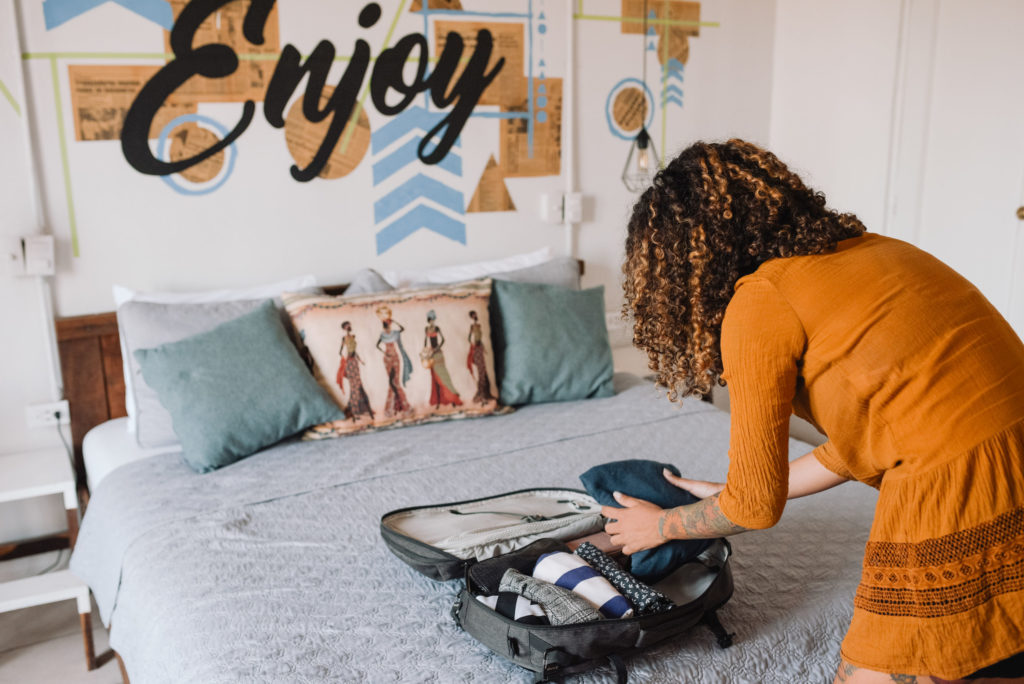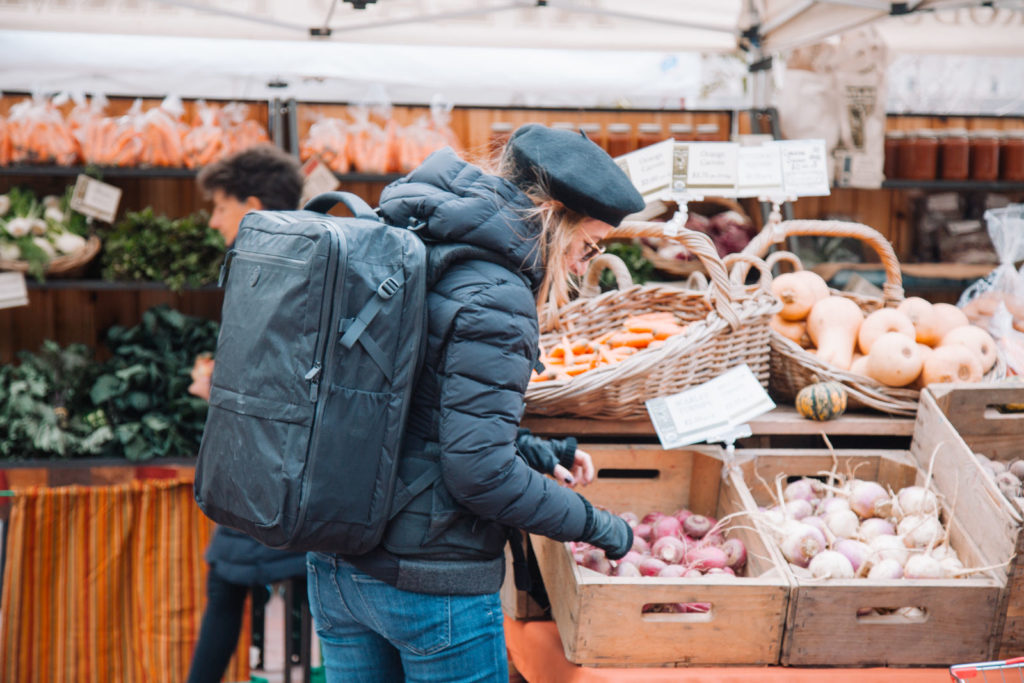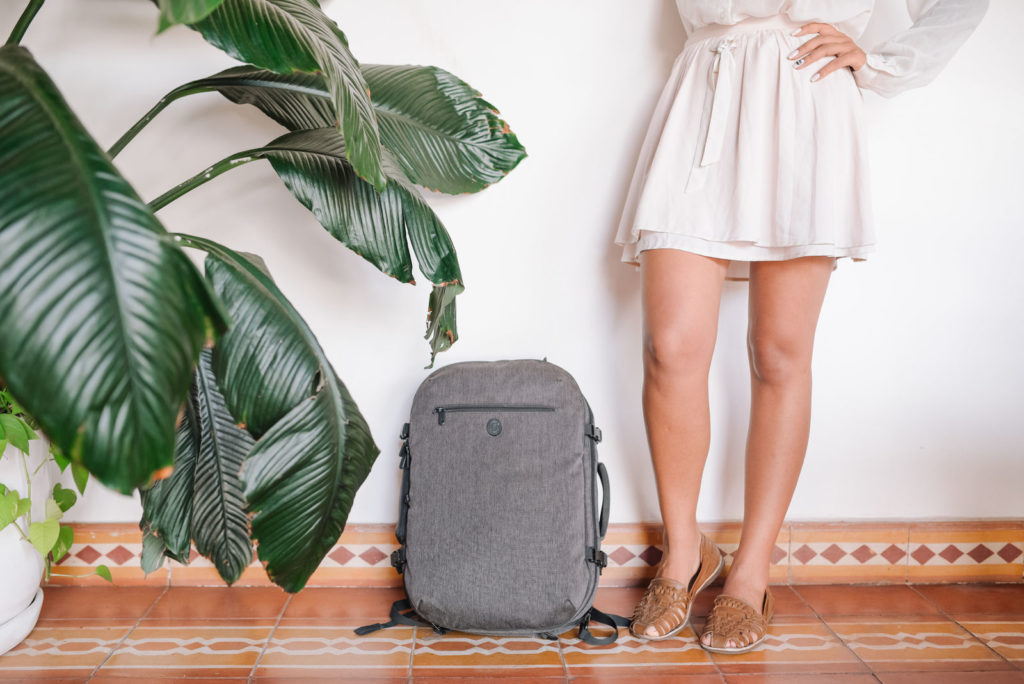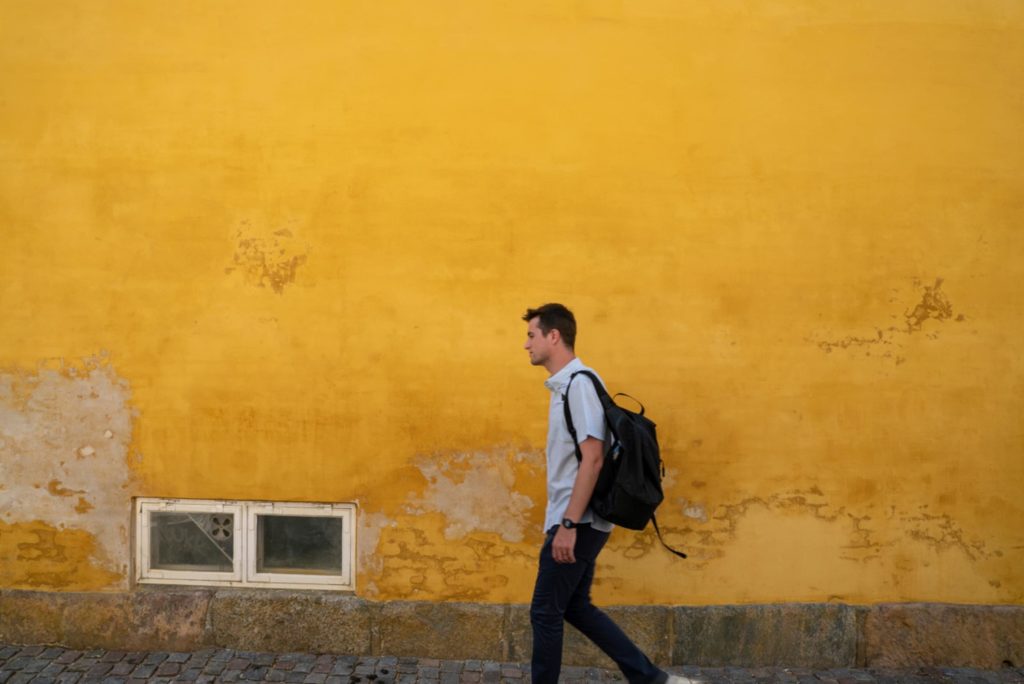7 Secrets to Packing Light

The Tortuga Promise
At Tortuga, our mission is to make travel easier. Our advice and recommendations are based on years of travel experience. We only recommend products that we use on our own travels.
Table of Contents
If you’re new to packing light, you first need to learn the rules. You’ll need to know what size and weight of luggage is allowed and what you can pack in your carry on bag.
Once you understand the rules, you can move on to the guiding principles that will help you get the most out of your allowed packing space.
Your exact packing list will depend on your destination, the length of your trip, the weather, and what you plan to do. The seven core principles in this article apply to any and every trip.
Packing is like grammar. You have to know the rules before you can break them. Learn to work within these constraints, then you can start to freestyle.
Pack for trips of one week or more without checking a bag.
- Thick comfortable straps
- Easy to organize
- Durable, waterproof fabric
- Backed by our Worldwide Warranty
#1: Pack “Must Have,” Not “Just In Case”
When preparing to travel, lay out all your clothes and all your money. Then take half the clothes and twice the money.
Light packing requires sacrifices.
You can’t bring clothes for every possible situation. You should only bring what you wear on the average day.
Pack with the Pareto Principle, aka the 80/20 Principle, in mind.
Applied to packing this means that you should only pack the 20% of your wardrobe that you wear 80% of the time. Pack the stuff you usually wear. If you don’t reach for it all the time back at home, you won’t want to wear it on the road.
Bring your core wardrobe that you wear over-and-over at home. Those clothes will cover more than 80% of the situations you will encounter on the road.
On the off chance that you run into a situation that you didn’t pack for, buy or borrow what you need. Most of your “what if” scenarios will never happen. Don’t carry around extra physical and mental baggage “just in case.”
If a surprise does come up, you can solve it cheaply with a temporary solution, not one you have to deal with for your entire trip.
While spending a quarter working in Sydney, Australia, I planned a trip to Queenstown, New Zealand with a friend. I hadn’t packed a coat warm enough for winter in Queenstown, so I bought a cheap one locally in Sydney. When I got back from New Zealand, I sold the coat to a coworker who was planning a similar trip. They got a deal, and I made make most of the money that I’d spent. I considered the “lost” money the cost of a rental. Losing a few dollars on the exchange was better than dragging a winter coat from the US to Australia to New Zealand and back again.
Pack light and stay flexible. Deal with situations as they come, and you’ll get into some adventures along the way.

#2: Pack for One Week
Thanks to Anil at foXnoMad for helping to clarify this idea for me.
If you’re traveling for two weeks, or a month, or a year, or permanently, break your packing list down into a more manageable chunk: one week.
Planning for every possible contingency on a long trip is impossible.
Instead, pack for one average week. A week is a manageable amount of time. You can easily visualize one week of clothes. A year of clothes would be your entire closet.
If you’re traveling for longer than a week or two, you will need to do laundry. Pack accordingly.
On short trips, hand wash your basics like socks, t-shirts, and underwear in the sink between laundry cycles.
For longer trips, use a cheap wash-and-fold service or local laundromat.
In many countries, you can save time and money by dropping off your dirty clothes at a cleaning service. Then just pick up a neatly bundled package of your clean clothes the next day.
In San Francisco, wash-and-fold costs $15 for a huge sack of clothes that lasts me two weeks. At that price, I could do laundry three times, which would yield six weeks of clean clothes, for $45, less than the cost of checking a bag on a roundtrip flight. Most other cities will have cheaper services.
Doing laundry is cheaper than checking a bag.
Plus, you have all the other benefits of packing light: convenience, flexibility, and less mental and physical burden.
Pack for trips of one week or more without checking a bag.
- Thick comfortable straps
- Easy to organize
- Durable, waterproof fabric
- Backed by our Worldwide Warranty
#3: Pack Layers, Not Bulk
When traveling in cold weather or across multiple climates, dress in layers.
Packing multiple thin layers takes up less space and offers more flexibility than packing bulky items like sweaters and coats.
One heavy sweater will eat up so much space in your bag that you’ll never fit everything else you need.
A merino wool base layer or thermal shirt will keep you warm and can be layered with other items or taken off as the weather changes.
If you’ll be crossing multiple climates, pack for autumn. Picture cool mornings, warm afternoons, and cold nights. Pack for that day.
I often wear a t-shirt, base layer, and light jacket when heading out in the morning. As the weather changes, I can remove one or both of the outer layers. When the sun sets, I can put them back on.
Dressing in thin layers offers this flexibility and keeps your pack light. Two t-shirts and two base layers can take up even less space than a sweater.
If traveling in very cold, wintry weather, wear an ultralight down jacket or a fleece jacket. Most importantly, don’t pack your jacket. Wear it if your whole trip will be cold. The next section will tell you why.

#4: If It’s Bulky, Wear It
If you need something bulky—like a sweater or a winter-weight coat—wear it, don’t pack it.
On winter trips, wear your coat. When wearing the coat on the entire trip is impractical—like if the trip includes time in warmer climates—don’t bring any coat at all. Pick up a cheap one at Goodwill when you land, then sell or donate it when you leave. Or, clip a packable jacket to the outside of your bag to save space on the inside.
The same goes for sweatshirts and sweaters. We recommend skipping them in favor of thinner layers as outlined above. But, for cold weather trips, you can bring a sweater if you wear it while you’re in transit. Sweatshirts and hoodies are perfect for cold airplanes. Just don’t waste your precious packing space on them.

#5: Pack Your Lightest Pair of Shoes
Shoes are the most common reason that people overpack. This hurdle trips up lots of people, men included.
Here are my simple, no-brainer rules to follow:
- Bring no more than two pairs of shoes, including the ones you’re wearing.
- Wear the bulkier pair, typically sneakers or boots.
- Pack the smaller pair. They must be flat and light. Think flip flops, sandals, flats, espadrilles.
Problem solved. Don’t let your shoes be the reason that you don’t pack light.

#6: Wear the Right Fabrics
To pack light for any weather, consider the fabrics that you’re wearing.
Cotton is a common but poor choice on the road because it gets smelly, wrinkles easily, and dries slowly.
I recommend merino wool and synthetic performance fabrics.
Merino wool is ideal because it keeps you warm in the winter and cool in the summer. The downside is that high-quality wool clothing can be expensive.
Merino wool t-shirts can cost $40-80. Wool socks can cost $10-20 per pair.
Treat wool clothes as an investment. Save up. Buy a small number of high-quality pieces.
Don’t think about the total price. Think about the cost per wear. Cost per wear is how I justify buying expensive jeans. A well-built pair of raw denim jeans are expensive. But I wear them every day, and they’re tough as hell. If anything happens, I get them patched up and keep wearing them.
Buy good stuff so you can buy less stuff.
Performance fabrics are cheaper than wool. They do a nice job of wicking away sweat but will smell bad if you don’t wash them after wearing them.
Blends can also be a great solution. Triblend t-shirts blend the best attributes of synthetics and cotton into a shirt that doesn’t wrinkle, doesn’t hold on to bad smells, and feels like a natural fiber. Merino wool blends can have all of the benefits of merino but with more durability at a lower price. You don’t have to choose between the tradeoffs of natural and synthetic fabrics. You can have it all.

#7: Simplify Your Color Palette
Pick a simple, neutral color palette and only pack clothes that fit that palette.
By sticking to a simple color palette, you can maximize the number of outfits for the clothes that you’re bringing. Everything should match. Anything can be worn with anything else.
For example, four shirts and four pairs of pants should yield sixteen, not four, outfits. Four tops times four bottoms equals sixteen outfits (4 * 4 = 16).
Bring pieces, not complete outfits, to maximize the number of looks that your travel wardrobe can yield.
Limit harder-to-coordinate colors and patterns to accessories. Wear that printed scarf if it makes you happy.
Bonus: Pack the Right Bag
When it comes to packing, people tend to fill the space they have. The simplest way to pack less is to give yourself less space in which to pack.
Choose a carry-on-sized bag. If you’re new to packing light, that size might feel restrictive at first. That’s okay. Constraints are good. Many people, once they’re used to packing in a
I brought a bag that was way too big on my first trip to Europe. So, of course, I packed way too much stuff including a pair of dress shoes that I carried around and didn’t wear even once.
The Tortuga Travel Backpack is carry-on-sized, organized for easy packing, and comfortable to carry. For even more organization, use a set of packing cubes.
The right, carry-on-sized bag, will make packing light easy.





